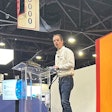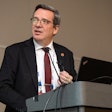“Robotics have improved feed efficiency and many other areas,” remarked Dr. Colin Usher, senior research scientist at the Georgia Tech Research Institute, during his presentation on “The Use of Robotics in Poultry Production,” at the la Cumbre Avícola Latinoamericana (Latin American Poultry Summit) program held during the 2019 International Production & Processing Expo. Usher examined some of the advantages of using robots in broiler chicken houses, including helping with broiler management and house decontamination. He observed that robots can monitor air quality, temperature, gasses, humidity, as well as sense light levels.
As part of his discussion on “Biosecurity for Latin America: How to Coexist with Non-Commercial Neighbors,” Anthony Pearson, global technical advisor for Lanxess, stated that “the global demand for agricultural commodities is increasing due to growing population and rising income. Latin America is a key producer with areas capable of further growth. Large and small farms need to find a proper balance. They need to coexist, flourish and grow together.” He suggested that building trust among neighbors should follow the TRUST philosophy: Talk with your neighbor through a transparent exchange of views and concerns; Respect one another; Understand each other’s challenges and methods; Share knowledge, data and experiences; and Take time to build trust.
Dr. Cesar de Anda, president of Innova Feed Groups, discussed the importance of eggs in the Latin American diet, remarking that they are a high-quality protein source, low cost and accessible to everyone. He commented that the egg market revolution in Latin America has followed the tendencies of the European and North American markets by going to cage-free layer production. He stated that “quality will prevail on the shelves, and the industry will have to be more devoted to demand a better raw material.”
Dr. Paul Aho, president of Poultry Perspective, provided information on the future of world grain production and prices in the year 2030. He noted that the world economy is supposed to grow 3.5 percent between 2020 and 2030, with more developing countries and a higher demand of protein in the world. Aho said that “corn production in the U.S. will have a larger increase than soy, and the world will be looking towards Latin America for soy production. Prices between now and 2030 will increase, as well as the price of other commodities.”
















